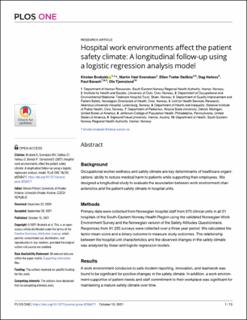Hospital work environments affect the patient safety climate: A longitudinal follow-up using a logistic regression analysis model
Brubakk, Kirsten; Svendsen, Martin Veel; Deilkås, Ellen C Tveter; Hofoss, Dag; Barach, Paul; Tjomsland, Ole
Peer reviewed, Journal article
Published version
Permanent lenke
https://hdl.handle.net/11250/2979872Utgivelsesdato
2021Metadata
Vis full innførselSamlinger
- Artikler [5068]
- Publikasjoner fra CRIStin FHI [7544]
Sammendrag
Background: Occupational worker wellness and safety climate are key determinants of healthcare organizations' ability to reduce medical harm to patients while supporting their employees. We designed a longitudinal study to evaluate the association between work environment characteristics and the patient safety climate in hospital units. Methods: Primary data were collected from Norwegian hospital staff from 970 clinical units in all 21 hospitals of the South-Eastern Norway Health Region using the validated Norwegian Work Environment Survey and the Norwegian version of the Safety Attitudes Questionnaire. Responses from 91,225 surveys were collected over a three year period. We calculated the factor mean score and a binary outcome to measure study outcomes. The relationship between the hospital unit characteristics and the observed changes in the safety climate was analyzed by linear and logistic regression models. Results: A work environment conducive to safe incident reporting, innovation, and teamwork was found to be significant for positive changes in the safety climate. In addition, a work environment supportive of patient needs and staff commitment to their workplace was significant for maintaining a mature safety climate over time. Conclusions: A supportive work environment is essential for patient safety. The characteristics of the hospital units were significantly associated with the unit's safety climate scores, hence improvements in working conditions are needed for enhancing patient safety.
